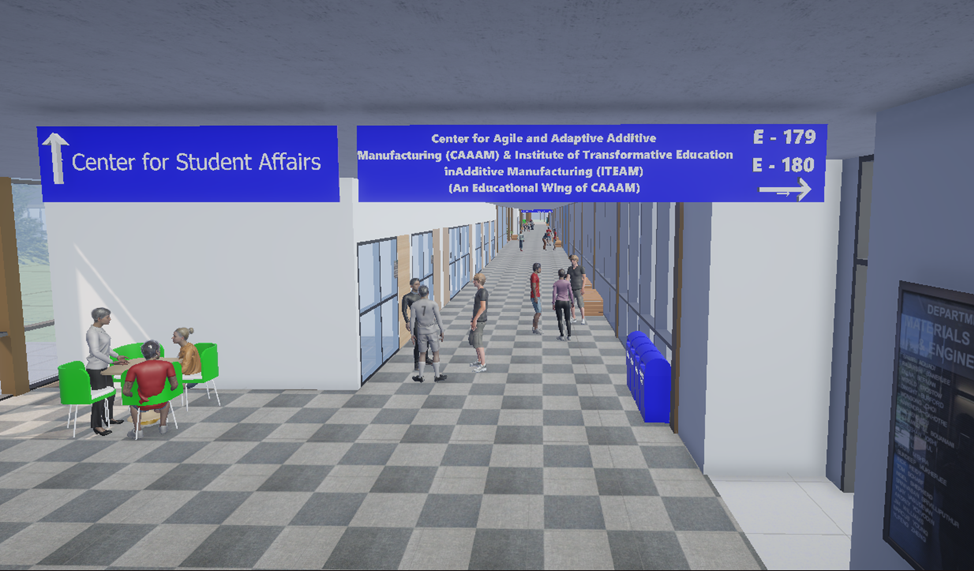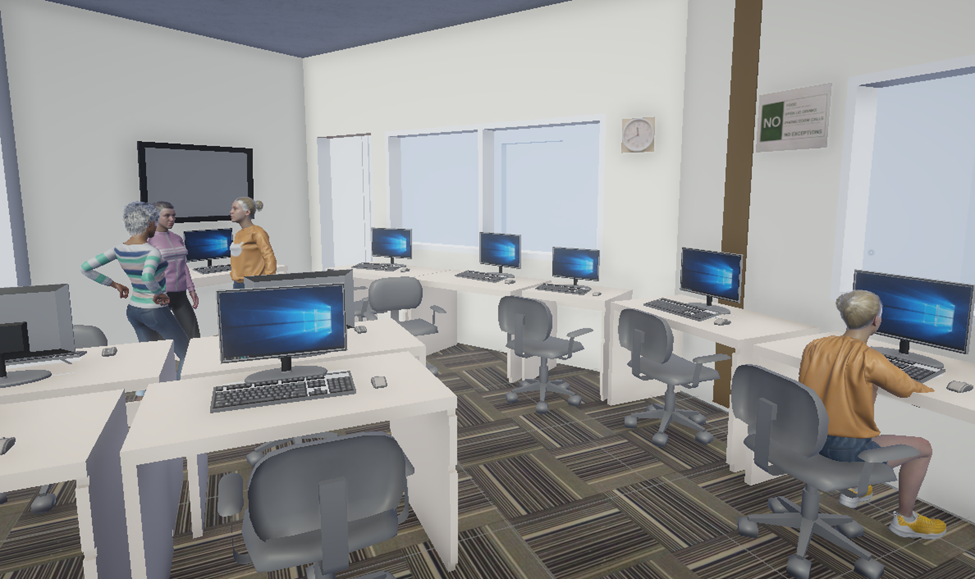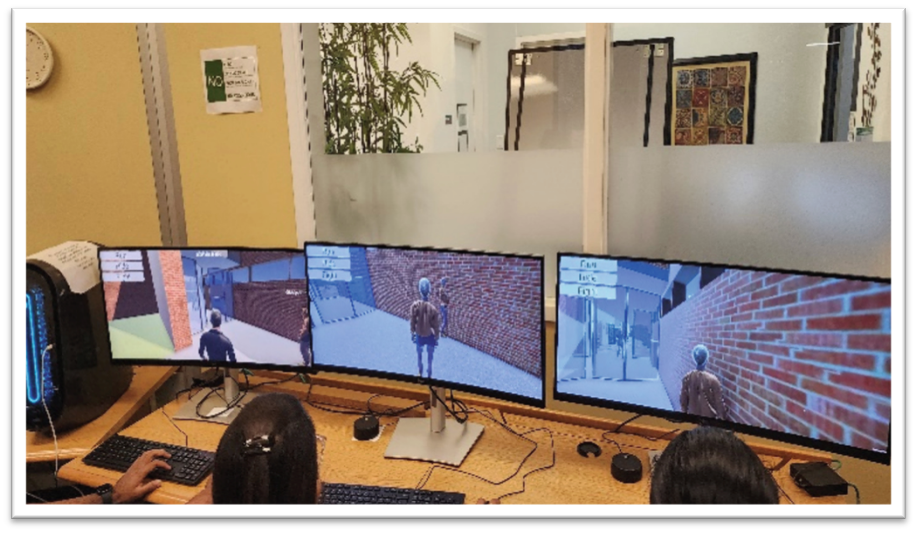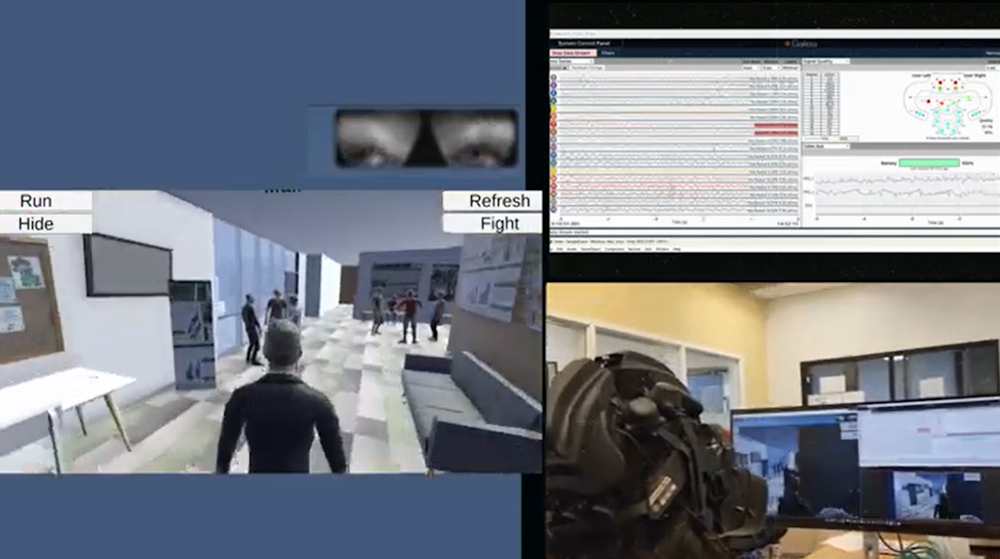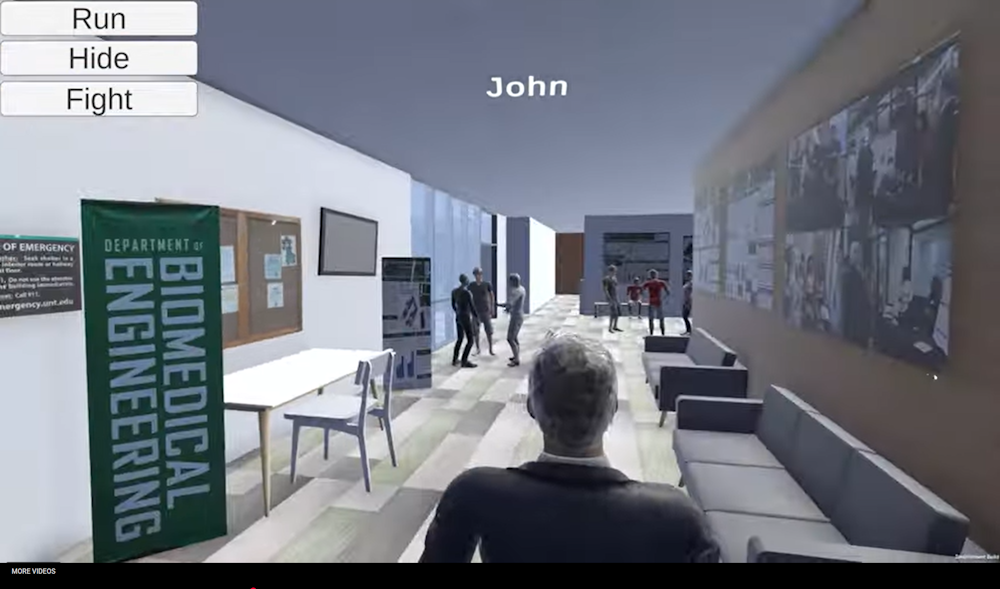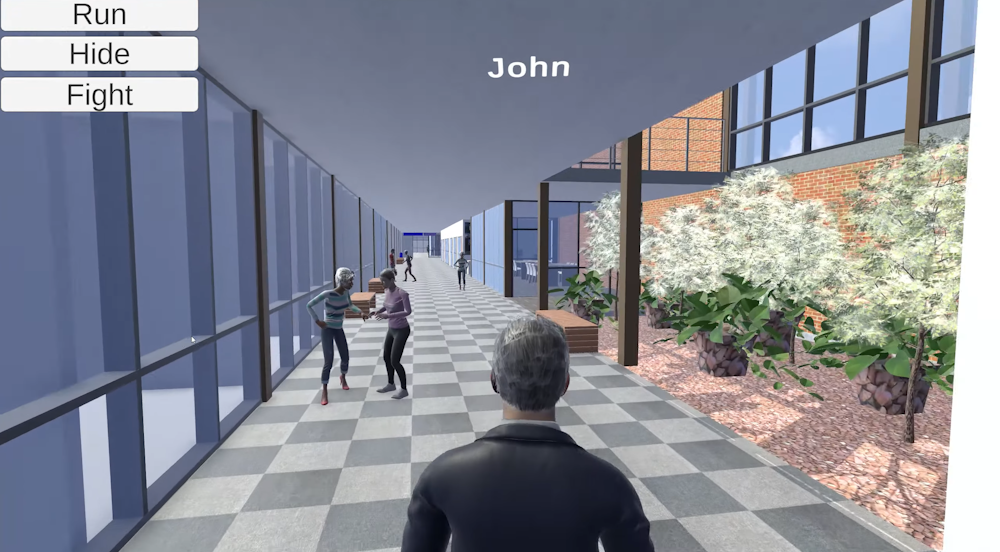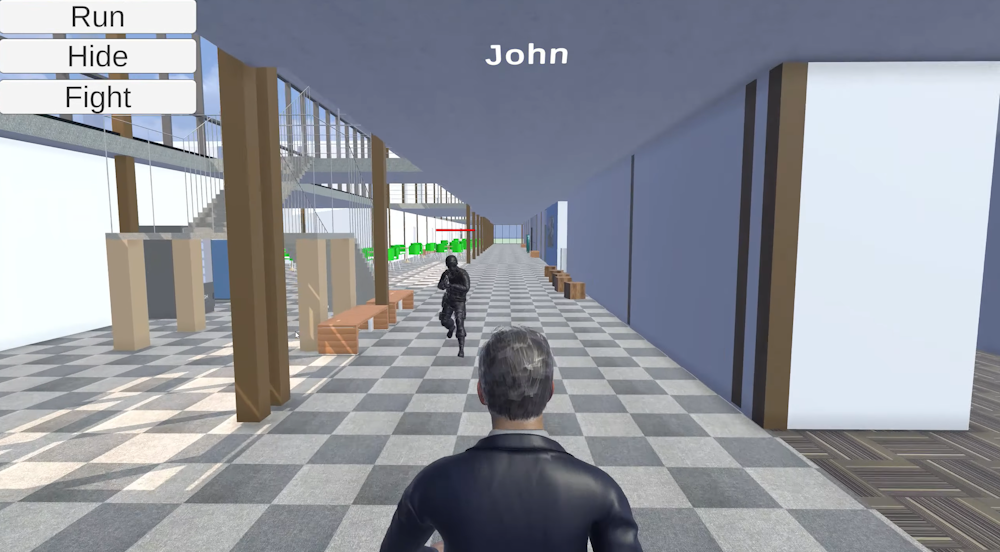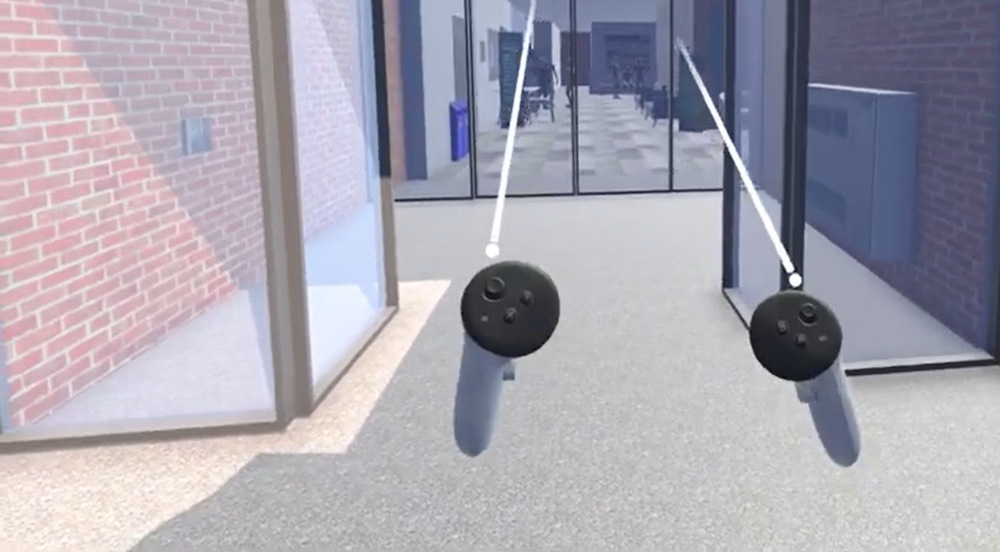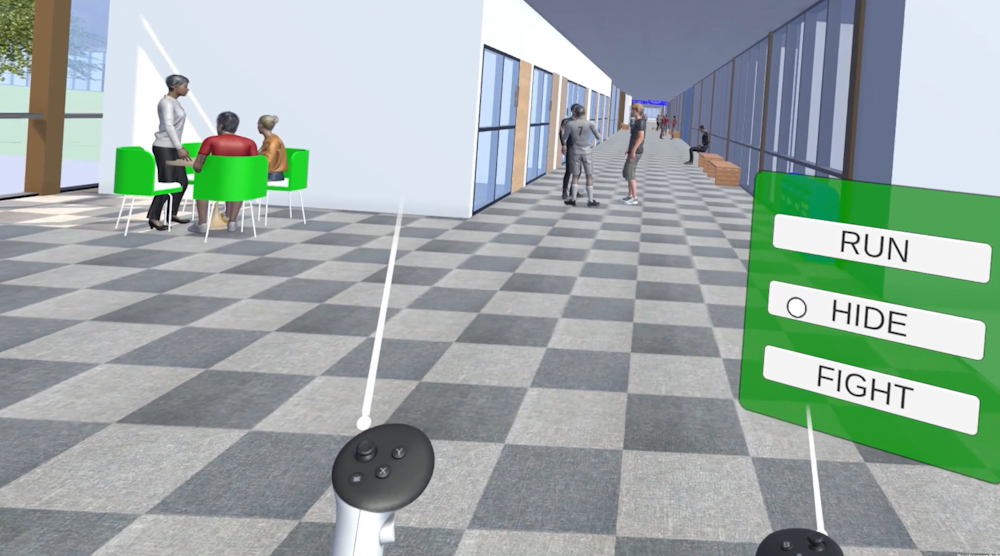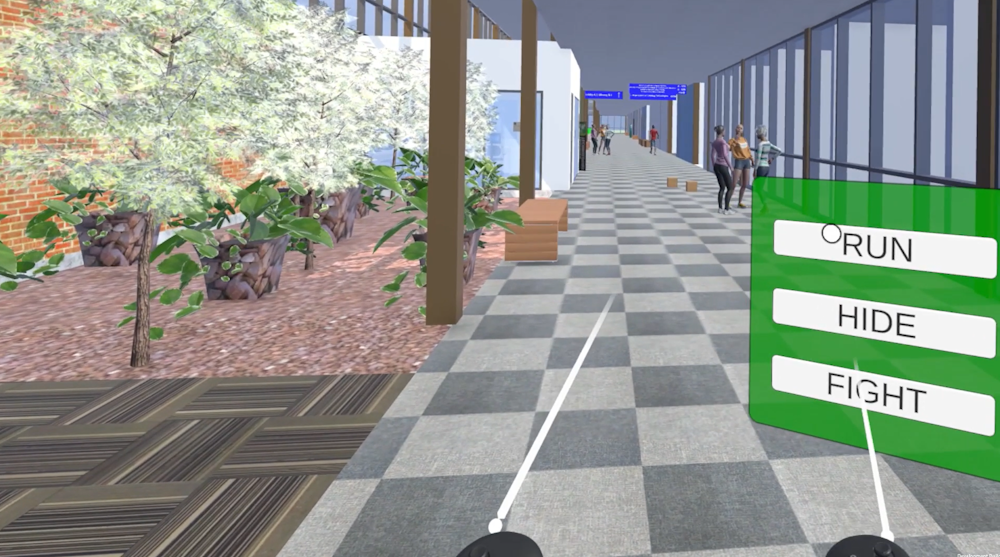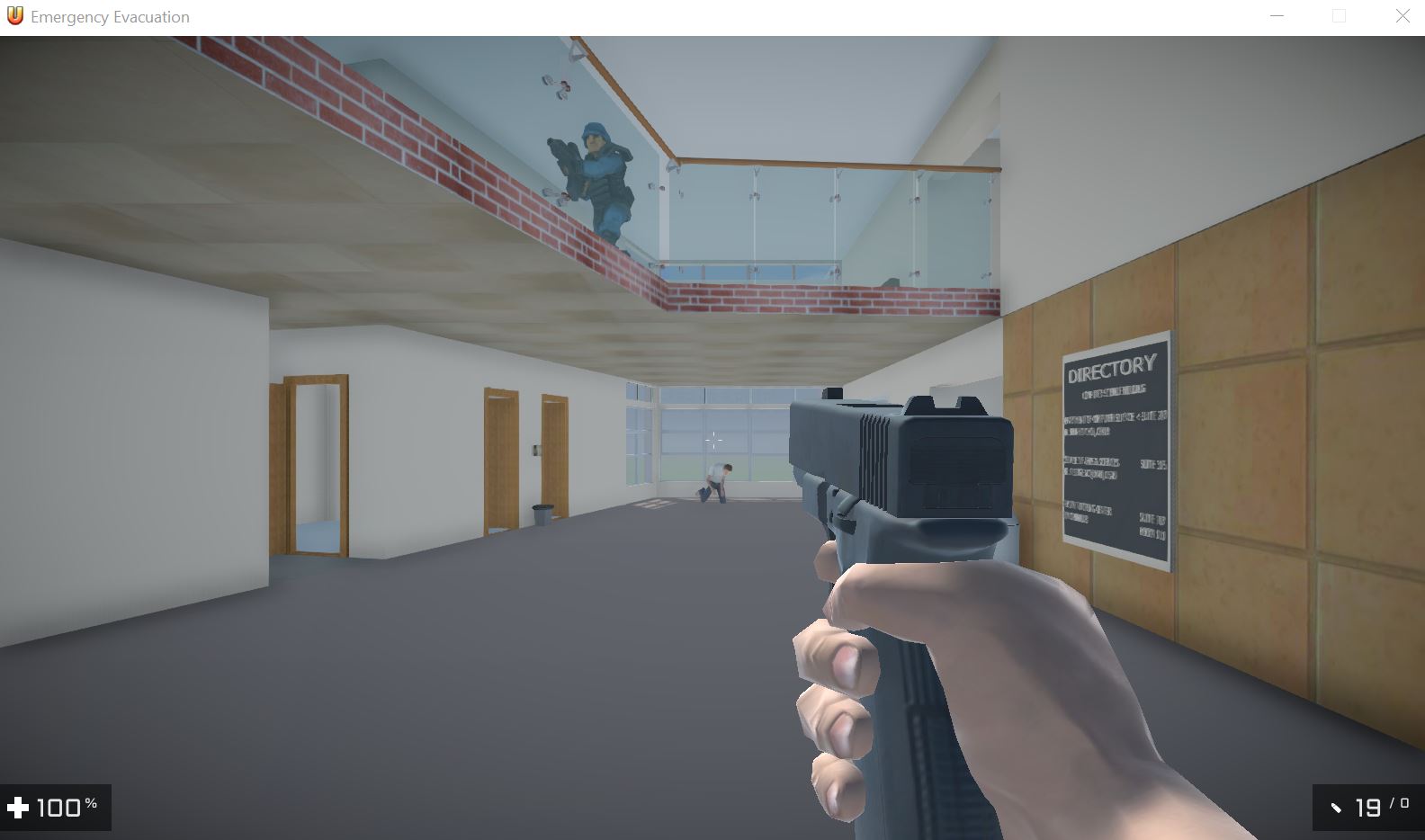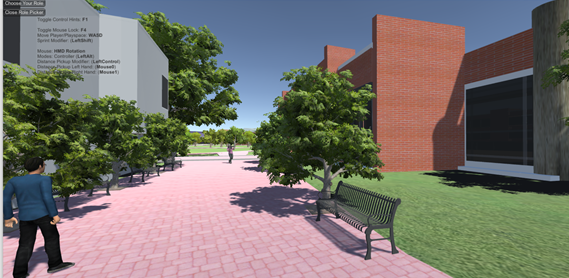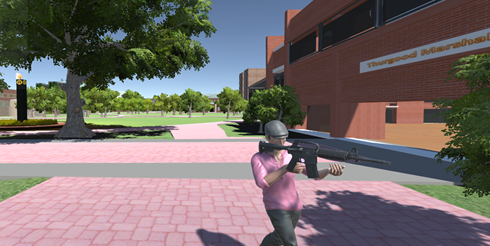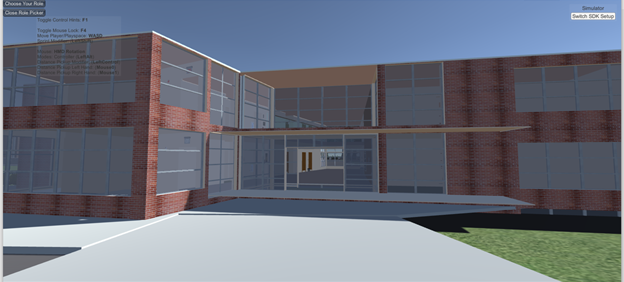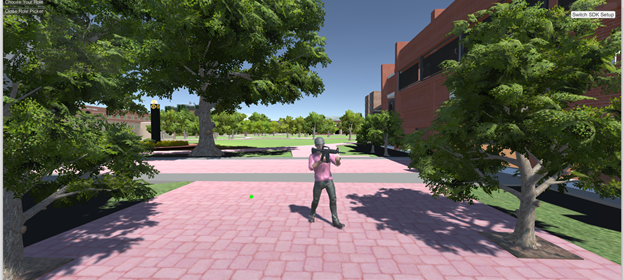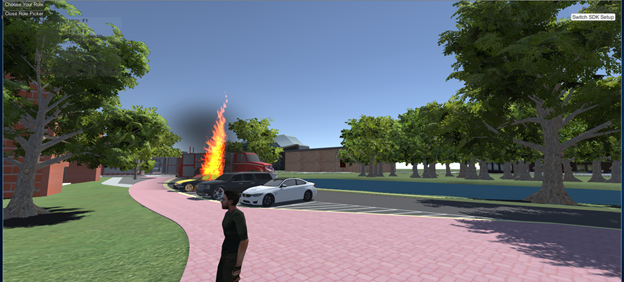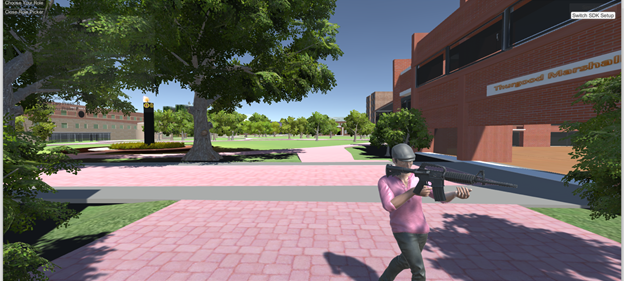Active Shooter Response VR Modules for Training and Decision Making
- Active Shooter Response & Training
- Virtual AI Tutor using Generative AI
- VR Fire Evacuation Training using Digital Twin and BCI
- NSF iHARP Grant: Annotation and Visualization of Heterogeneous Data
- Multi‐User Virtual Reality (MUVR)
- Virtual Reality Instructional (VRI) modules
- Megacity
- Active Shooter Response and Training for BSU Campus
- VRI Training for Quality of Care and Patient Safety
- Virtual Reality Classroom
- Human Centric Cyber Situation Awareness
- Back to DVXR Research
Active Shooter Response VR Modules for Training and Decision MakingCurrent Students: Pranav Moses, Keerthana Srinivasan, Johannas Meela Katikala, Past Students: Nanda Gowri Ganta, Bala Chikkala, Saivishal Thota, Sri Chandra Dronavalli, Phillip Devreaux, Pranay Rajeev, Dexter Ballerda, Manik R Arrolla Sri Teja Bodempudi, Srikanth Guntupalli, Abhaya Ladalla, Navatha Maloth, Pranitha Seemalamudi, Lavanya Nidamanuri Emergency response and active shooter training drills are essential for preparing for emergencies, as we cannot predict when they will happen. While progress has been made in understanding human behavior, unpredictability, human motion synthesis, crowd dynamics, and their connection to active shooter events, challenges still remain. We have developed an immersive collaborative virtual environment (CVE) for active shooter response for a campus building. The CVE was designed for corner cave and MetaQuest/oculus rift head mounted display to give the user a complete immersive experience of the campus. We are currently building the immersive collaborative virtual environment (CVE) for active shooter response at discovery park building on UNT campus. The immersive virtual campus environment can be also helpful to understand the campus environment and better know and navigate the university campus leaving the users no stress of walking or coming to campus just to view the campus. Immersive collaborative virtual reality environment also offers a unique way for training in the emergencies for campus safety. The participant can enter the collaborative virtual reality environment setup on the cloud and participate in the evacuation drills which leads to considerable cost advantages over large scale real life exercises. Our contribution also lies in our approach to combining computer simulated agents (AI agents) and user-controlled autonomous agents in a collaborative virtual environment for conducting emergency response training for security personnel's and building occupants. Thus, it will allow for more effectively employing existing resources in preparing and training for an event and have more effective investment strategies. The emergency response training and exercises are the paths to implementing emergency operation plans (EOP) and translating them into action. 1) Immersive Active Shooter Response Module for UNT Building using MetaQuest 3 and Unity 3D (Run, Hide, & Fight)The immersive collaborative virtual reality environment for performing active shooter training scenarios using MetaQuest 3 head mounted display. The collaborative immersive environment is implemented in Unity 3D and is based on run, hide, and fight mode for emergency response. We have conducted user studies to evaluate the effectiveness of our CVE module (immersive and non-immersive) for active shooter response training and decision-making using the Group Environment Questionnaire (GEQ), Presence Questionnaire (PQ), System Usability Scale (SUS), and Technology Acceptance Model (TAM) Questionnaire. The results show that the majority of users agreed that the sense of presence intrinsic motivation, and self-efficacy was increased when using the immersive emergency response training module for an active shooter evacuation environment. 2) Immersive Security Personnel module for Active Shooter response using ALERRT (Advanced Law Enforcement Rapid Response Training) frameworkThe security personnel module was developed grounded in the ALERRT (Advanced Law Enforcement Rapid Response Training) framework. The security personnel training module was further organized into four sub-modules: 1) Situational assessment module, 2) Individual officer intervention module, 3) Team Response Module, and 4) Rescue Task Force module. The VRI modules were developed using the Unity 3D game engine and SketchUp modeling software, enabling the construction of both immersive (head-mounted display) and non-immersive (desktop-based) training environments. This combination of technologies allowed the research team to create visually accurate building replicas, support multi-user interactions, and implement dynamic simulations that respond to user behavior, leading to a highly adaptable and realistic training platform.
3) Immersive Active Shooter Response Module for CS Building using Oculus S (Run, Hide, & Fight) AT BSUThe immersive collaborative virtual reality environment for performing virtual building evacuation drills and active shooter training scenarios using Oculus Rift S head mounted display. The collaborative immersive environment is implemented in Unity 3D and is based on run, hide, and fight mode for emergency response. The programing is done in C# using Microsoft visual studio. C# scripts are used for Animations and for Event triggers in this game. The user can enter as CVE in two modes: Security officer or as building occupant (student, staff, faculty and visitor). The user-controlled agents are able to enter the CVE using Oculus Rift S and are able to respond to emergency situations like active shooter events, bomb blasts, fire and smoke. This platform can be fully immersive with the use of Oculus rift Touch controllers as shown in figure/videos below. 4) Active Shooter Response Module for Security Personnel at BSUOur developed CVE can be used for training security agents as well as to conduct emergency response training for building occupants based on run, hide, and fight mode.
5) Multi-user Active Shooter Response Module for CS Building using Unity 3D at BSUOur proposed CVE can be used for training security agents as well as to conduct emergency response training for building occupants based on run, hide, and fight mode. This module is designing to train people how to handle active shooter situation in a computer science (CS) building in Bowies State University.
6) Active Shooter Response for BSU CampusOur vision is for the immersive VR to ultimately become a platform for emergency training that is deployed across institutions of higher education (IHE). The intellectual merits are the new notions of building the experimental setup for conducting active shooter response training in VR. It is a new concept similar to VR First-Person Shooter (FPS) game. 7) Using Corner CaveStudents are interacting with the CVE of the University Campus. They are inside a classroom in Computer Science builiding wearing 3D glasses and wand. Click the below web Links to Open the BSU Campus on a browser (Use key board and mouse to navigate) Link to Virtual BSU Tour with New Science Building Link to Virtual BSU Tour Link to Virtual BSU Tour |
||||||||||||||||||||||||||
[Acknowledgement:This study was supported by National Science Foundation, Award HRD‐2131116, 2026412, and initially in part by Award Number: HRD-1238784, 1137541]
Publications
- Sharma, S., Moses, P.A., "Immersive Active Shooter Response Training and Decision-Making Environment for a University Campus Building", In: Chen, J.Y.C., Fragomeni, G. (eds) Virtual, Augmented and Mixed Reality. HCII 2025. Lecture Notes in Computer Science, pp 220–232, vol 15790. Springer, Cham. https://doi.org/10.1007/978-3-031-93715-6_14, 2025.
- Sharma, S, Moses, P., "A Collaborative Virtual Reality Environment Module for Active Shooter Response Training and Decision Making", Proceedings of the IS&T International Symposium on Electronic Imaging (EI 2025) in the Engineering Reality of Virtual Reality Conference, https://doi.org/10.2352/EI.2025.37.13.ERVR-169, pp 169-1 - 169-7, 2025.
- Omary, D., Gamineedi, S.K., Shareef, A., Sharma, S. , "Virtual Reality Fire Drill for Campus Evacuation", In: Latifi, S. (eds) The 22nd International Conference on Information Technology-New Generations (ITNG 2025). ITNG 2025. Advances in Intelligent Systems and Computing, vol 1463, pp 568–579, Springer, Cham. https://doi.org/10.1007/978-3-031-89063-5_49, 2025.
- Sharma, S., Park, J.W, Morris, B. T, "Immersive security personnel training module for active shooter events," Proceedings of the IS&T International Symposium on Electronic Imaging (EI 2023) in the Engineering Reality of Virtual Reality Conference, January 15-19, 2023.
- Arteaga, C., Park, J.W, Morris, B.T, Sharma,S., "Effect of trained evacuation leaders on victims' safety during an active shooter incident", Elsevier Safety Science, ISSN 0925-7535, https://doi.org/10.1016/j.ssci.2022.105967, Volume 158, 105967, 2023.
- Sharma, S., Ali, S., "Multi-agent Crowd Simulation in an Active Shooter Environment”, Proceedings of the 24th International Conference on Human-Computer Interaction, Thematic Area: Virtual, Augmented and Mixed Reality, LNCS 13318, pp. 1–13, Washington DC, 26-1 July 2022.
- Sharma, S., Bodempudi, " Immersive Virtual Reality Training Module for Active Shooter Events, Proceedings of the IS&T International Symposium on Electronic Imaging (EI 2022), in the Engineering Reality of Virtual Reality, DOI: https://doi.org/10.2352/EI.2022.34.12.ERVR-299, pp 299-1 - 299-6, January 2022.
- Sharma, S, Bodempudi, S.T., Scribner, D., Grazaitis, P, "Active Shooter response training environment for a building evacuation in a collaborative virtual environment", IS&T International Symposium on Electronic Imaging (EI 2020), in the Engineering Reality of Virtual Reality, DOI: https://doi.org/10.2352/ISSN.2470-1173.2020.13.ERVR-223, Burlingame, California, 26 January- 30 January 2020.
- Sharma, S, Bodempudi, S.T., "Improving emergency response training and decision making using collaborative virtual reality environment for building evacuation", Proceedings of the 22nd International Conference on Human-Computer Interaction (HCI International 2020), Thematic Area: Virtual, Augmented and Mixed Reality, Copenhagen, Denmark, 19-24 July 2020.
- Sharma, S., Bodempudi, S.T., "Identifying anomalous behavior in a building using HoloLens for emergency response", IS&T International Symposium on Electronic Imaging (EI 2020), in the Engineering Reality of Virtual Reality, Hyatt Regency San Francisco Airport, Burlingame, California, 26 January- 30 January 2020.
- Sharma, S, Jerripothula, S., Devreaux, P., "An Immersive Collaborative Virtual Environment of a University Campus for performing Virtual Campus Evacuation drills and Tours for Campus Safety", proceedings of IEEE/ACM International Conference on Collaboration Technologies and Systems (CTS 2015), Atlanta, Georgia, USA,ISBN: 978-1-4673-7646-4, page 84-89, DOI: 10.1109/CTS.2015.7210404, June 01-05, 2015.
- Phillip Devreaux and Dr. Sharad Sharma, "Virtual Tour of University Campus Using Oculus Rift", Oral Presentation, at the Emerging Researchers National (ERN) Conference in STEM, hosted by AAAS, EHR and NSF, on Washington DC, on February 25-27, 2016.
- Isaac Amo-Frempong and Dr. Sharad Sharma, "Virtual Evacuation Drill in a Multi-user Environment", Oral Presentation, at the Emerging Researchers National (ERN) Conference in Science, Technology, Engineering and Mathematics (STEM), hosted by AAAS, EHR and NSF, Washington DC, February 19-21, 2015.
